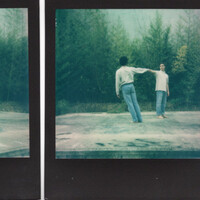Thu 15 Jun: ANDREW SCOTT/ NIKITA DE MARTIN/ SANYA MALNAR X MARIANNE RAYNAL
News Story
Andrew ScottA Three Part Drama
Nikita De Martin3m²
Sanya Malnar x Marianne RaynalB brain(s)
Andrew Scott’s, A Three Part Drama, takes us through a dramatic loop of love and loss clearly demonstrated in the cyclical repetition of a dynamic, detailed gestural phrase. This is thankfully but inexplicably interrupted by a recitation of a voicemail that points to great feeling without entirely connecting to it. A third section juxtaposes as Scott refreshes the space with a delightfully lighthearted and exaggerated depiction of love. A predictable but satisfying ending comes as the original phrase returns yet again- I only wonder if there’s a way to rebel against the logic to find a more nuanced, perhaps emotional, approach to this cycle that this artist clearly possesses.
The stage is set for 3m² with a scattering of luminescent body castings, rocks and two wooden boards in the centre of the round. Nikita De Martin enters walking through the scene as she speaks cryptically about time, bodies and connection over ASMR sounds. Heavily metaphored, I find myself at times lost in the elements of the work, but the creation of a balance board reinvigorates my interest as De Martin brings real stakes to the performance. The instability strongly evokes the feelings of uprootedness, and I’ll choose to interpret the rest of the elements as the disconnection between body and mind she described.
Shaking things up with a duet, Sanya Malnar and Marianne Raynal perform an atmospheric exploration of ‘existential perception’. I appreciate how the two performers carve their individual experiences within the world they create, to the point where I questioned if they were even in the same world. Eccentric multi-plaid costumes and playful makeup are well-displayed as they pose intensely between punctuated black-outs. An effective motif of body-doubling, literally matching up their body parts, combined with well-placed unison syncs them together in their intentional, committed movement. One question remains: how can you end a piece when the world and the experience keeps on going?
Sarah Lapinsky
Andrew Scott enters, searching the audience with his gaze, but not really seeing them. There’s a sense he is in his own world and his movement holds the same internalised quality. He stops abruptly and exits, before returning to repeat the scene again. The concept for A Three Part Drama is clear. Navigating the multiple emotions that surround a struggle to let go of relationships that have passed, Scott is stuck in a repeating loop; first in movement and later in a monologue that tumbles through scattered thoughts. It’s an interesting premise, and a playful dance performed with forced happiness beneath rose-tinted lights, suggests the extremities and fragility of the emotions experienced. Yet the ambiguity of Scott’s unspecified situation infiltrates the work. ‘I’m very confused,’ he mutters. A Three Part Drama offers a clear depiction of the difficulty to move on; its repetitive nature requires a few more hooks to allow its audience to move with it.
Nikita De Martin’s3m² makes use of the evening’s ‘in the round’ setting through its design. Translucent casts of body parts, lit from within, are scattered across the stage with torsos hung on the walls behind the audience. It's an effective visual choice, though the performance itself remains centre-stage. Moving slowly as she relates a sensorial, self-reflective monologue, Martin reconfigures her set, though exactly what her words and actions relate to feels unclear. Accompanied by an engaging and highly textural audio landscape, the words spoken become difficult to define. Besides a brief burst of movement, 3m² continues at a steady, monotonous pace. It’s a thoughtful piece, though without a readable intention it remains in a world of reflective, poetic abstraction - and we can only drift in that sensation.
Sanya Malnar and Marianne Raynal’s B Brain(s) is a considered, carefully curated work. Switching between blackout and spot-lit tableau, the two repeatedly reset their physical positions, their movement imbued with a twisting, lethargic quality that gives the effect their bodies are somehow disconnected from their personal being. An abstract contemplation on existential perception, B Brain(s) doesn’t prescribe what you might take from it, but the sensations conveyed are strong. That attention to detail is echoed throughout, particularly in the quirky, playful aesthetic of make-up and costume and the synchronicity between the two dancers - despite their movement being predominantly independent of each other. It’s an engaging, curiously atmospheric piece.
Rachel Elderkin


